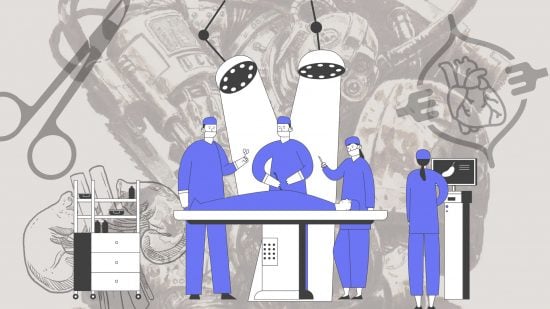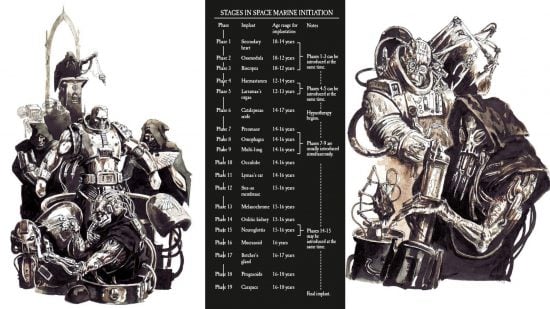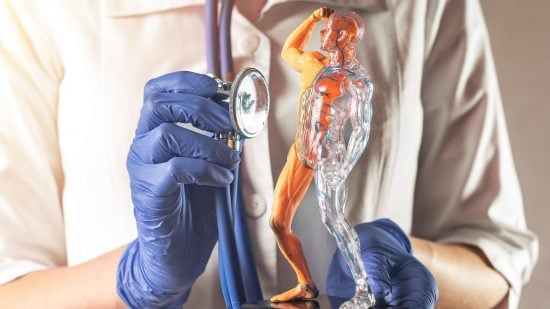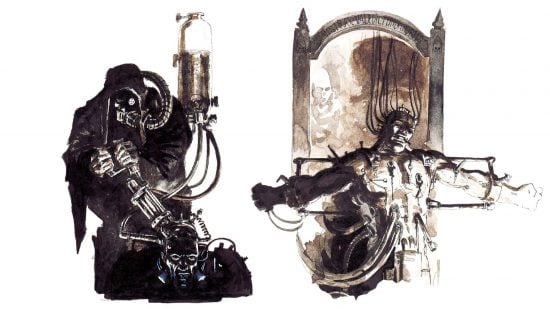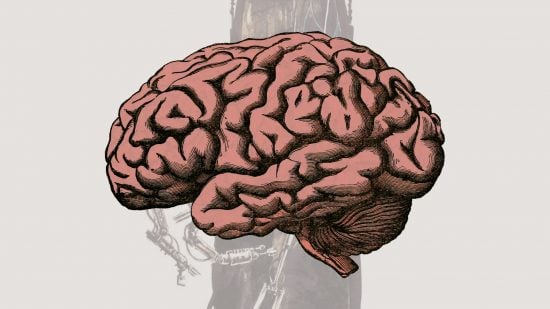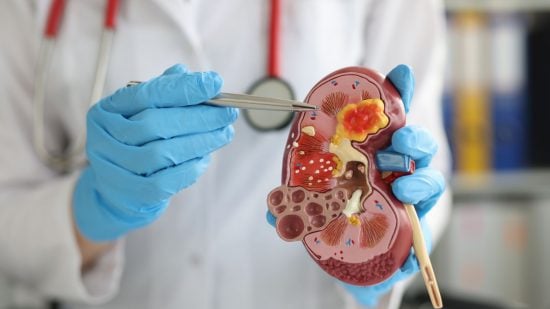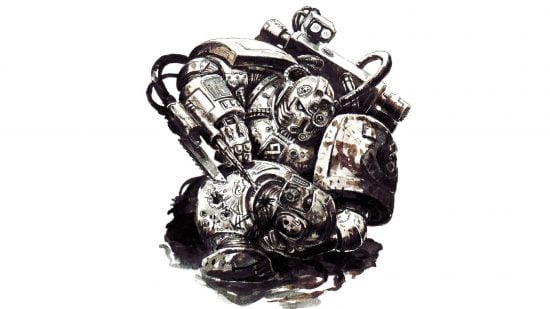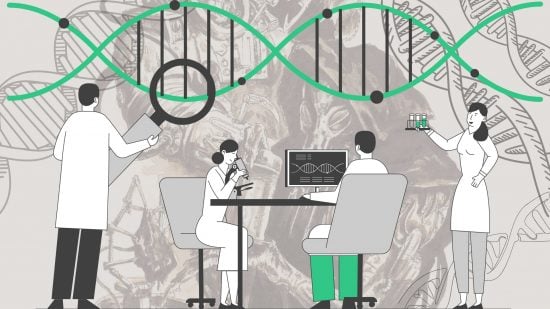22 Space Marine organs separate them from normal humans, imbuing them with superhuman strength, the ability to forego sleep, enter suspended animation, and many more magical powers. My name’s Dr Joe, Wargamer’s resident accredited doctor, and in this guide I’ll explain each Space Marine implant in turn, and use medical science to explain why many of them would be utterly useless.
Nineteen species of organs were created in the gene-labs of the Emperor of Mankind at the dawn of the Imperium of Man, implanted into his Space Marine legions to give them the strength necessary to conquer the galaxy. ‘Gene-seed’ harvested from the progenoid glands of living or dead Space Marines is implanted into neophytes, creating the next generation of warriors for a Space Marine Chapter. In the current Warhammer 40k timeline, the Adeptus Mechanicus inventor Belisarius Cawl has added a further three organs to create the even more powerful Primaris Space Marines.
For this guide, I spoke with specialists in intensive trauma care, nephrology, orthopedic surgery, neurology, and emergency care. While accepting the premise that radical genetic engineering is possible in the 40k universe, I’ve evaluated each organ’s fictional functionality against real world biology, and a few other scientific disciplines. And the picture is pretty clear – even if we could create Space Marine organs, many of them simply wouldn’t work.
These are the 22 Space Marine organs:
- Phase 1 – Secondary Heart
- Phase 2 – Ossmodula
- Phase 3 – Biscopea
- Phase 4 – Haemastamen
- Phase 5 – Larraman’s Organ
- Phase 6 – Catalepsean Node
- Phase 7 – Preomnor
- Phase 8 – Omophagea
- Phase 9 – Multi-lung
- Phase 10 – Occulobe
- Phase 11 – Lyman’s Ear
- Phase 12 – Sus-an membrane
- Phase 13 – Melanochrome
- Phase 14 – Oolitic Kidney
- Phase 15 – Neuroglottis
- Phase 16 – Mucranoid
- Phase 17 – Betcher’s Gland
- Phase 18 – Progenoids
- Phase 19 – Black Carapace
- Phase 20 – Sinew Coils
- Phase 21 – Magnificat
- Phase 22 – Belisarian Furnace
Phase 1 – Secondary Heart
| Location | Chest cavity |
| Function | Backup in case the original heart is damaged, increases blood flow rate |
| Medical judgment | A liability |
So, slight shocker – surgeons can already add a secondary heart alongside the old one in real humans. It’s called a Heterotopic Heart Transplant (HHTx), and it’s used when a normal (orthotopic) heart transplant won’t work. It’s lifesaving for patients who need a new heart, but probably pointless in a superhuman soldier.
Space Marine size and metabolic rates don’t require more than one heart. Blue whales have one heart and they’re fine. Cheetahs, tigers, and other much-faster-than-us animals do just fine with one heart, too.
In fact a second, full-power pump creates problems, rather than solving them. It requires coordination for valve function, pressure loop synchronisation, and space in the prime real estate of the thoracic cavity.
Fast blood flow sounds good, but increased blood flow rate increases blood pressure, damaging key organs like kidneys, eyes and brains. You can keep the blood pressure low and the flow rate high by reducing the “peripheral resistance” to the flow of blood, but that will in turn reduce perfusion, the process of blood getting out of the pipes and into the actual organs.
A secondary heart on the same pipe system is also not a “back-up” in a military context, it’s a liability. Get shot in either heart, and you have a very large hole in the plumbing. Why double the number of “don’t hit me here” spots?
Doctor Who fans, hold your fire. I’m not even going to glance at Time Lord anatomy.
Phase 2 – Ossmodula
| Location | Base of the brain |
| Function | Enhances bone growth, causes fusing of the ribcage |
| Medical judgment | Nonsensical |
The ossmodula changes Space Marine bone growth, strengthening them and changing their composition. That’s believable if we accept a high level of genetic modification, but the rest of what the lore claims about this little guy makes no sense.
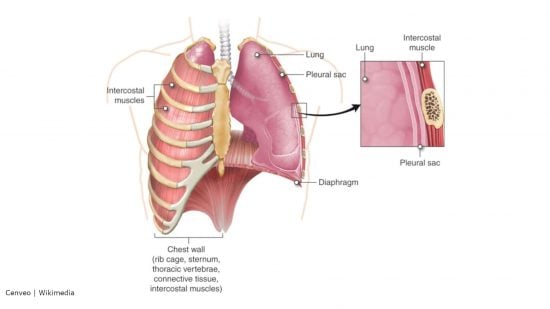
The Ossmodula causes the Space Marines ribcage to fuse into an armour-like structure. But your ribcage is flexible with gaps for a reason. Those gaps contain your intercostal muscles, which allow your ribs to move like a set of bellows, changing the pressure in your chest cavity and allowing you to breathe – one of mankind’s favorite hobbies.
Breathing, to my knowledge, is not optional for Space Marines. You can breathe from your abdomen, but would Space Marines sacrifice all the metabolic power from efficient, lung-powered breathing for the sake of a centimetre or two of bone? A single, solid sheet of non-malleable material that can still shatter uncomfortably?
One of Josh Reynold’s Fabius Bile books retcons this lore slightly, calling the ribs a series of overlapping plates. While that grants flexibility, where do the muscles now sit? If attached to the rear of each plate, that’s still a huge reduction in movement, and places a large muscle body between each rib. At full inhale, the marine chest would look like an alternating stack of shoehorns and sausages, and would still have meaty gaps for projectiles to enter and ricochet into high-value places.
Phase 3 – Biscopea
| Location | Chest cavity |
| Function | Enhances muscle growth |
| Medical judgment | Feasible, but counterproductive |
The biscopea secretes hormones to promote muscle growth. That sounds sounds great, but we already have organs that do that. Adding additional hormones will suppress our own, natural muscle growth pathways via negative feedback loops. You can see this in the side effects of doping with anabolic steroids and human growth hormone, which come with plenty of unwanted side effects.
Phase 4 – Haemastamen
| Location | Implanted into a major blood vessel |
| Function | Increases the efficiency of the blood |
| Medical judgment | Plausible, but a fancy spleen would be better |
The haemastamen, which increases the efficiency of the blood, is feasible but questionable. The question is, efficient in what way? Does it boost haemoglobin volume or oxygen saturation curve variance? There are costs to each of these changes, and having too much haemoglobin can cause a whole host of issues, like in Polycythaemia Vera.
Redesigning haemoglobin so that it can carry eight oxygen molecules, not just four, would work, but having spoken to some terribly clever colleagues, it would probably be more effective to store hyper-oxygenated blood in a modified spleen. You could pack it full of an emergency store, able to give you a fair few minutes of oxygen that could be released at once, mitigating the risks of super thick, haemoglobin heavy blood being there all the time.
Phase 5 – Larraman’s Organ
| Location | Chest cavity |
| Function | Allows super-rapid scarring and wound closure |
| Medical judgment | Possible, but not desirable |
The golf-ball sized Larraman’s Organ stores a new type of cell, ‘Larraman cells’, which function like superior platelets, the cells that help your blood to clot and form scabs. Since the ability to scab and scar already exists, an organ that turbo-charges that seems pretty reasonable.
There’s a problem though. When Larraman Cells come into contact with air they form an instant scar, healing wounds rapidly. That sounds good for your skin, but what about your lungs? Any pressure shock, toxin, or impact that causes the delicate alveoli in the lungs to rupture will immediately turn to scar tissue as the Larraman cells are exposed to the air. Scarred lung tissue (pulmonary fibrosis) can’t exchange gases, so a Space Marine’s Larraman cells will quite rapidly stop them from breathing.
Phase 6 – Catalepsean Node
| Location | Occipital lobe |
| Function | Allows space marines to wake and sleep simultaneously using different parts of their brain |
| Medical judgment | Not a chance, brains don’t work like this |
The Catalepsean Node is an organ implanted into brain’s the occipital lobe that allows a Marine to sleep and stay awake at the same time, by modifying circadian rhythms (the sleep-wake cycle) so that areas of the brain can be ‘shut off’ sequentially. While one part of the brain sleeps, the rest of the brain remains awake.
Circadian rhythms are controlled by the Suprachiasmatic Nucleus, not the occipital lobe, which is primarily visual, so this organ’s in the wrong place for a start. Sleep is also not something that happens in one place at a time. While some centers in the brain have a large modifying effect on specific skills or behaviors, it’s the connectivity through the brain which makes these systems work, and the whole brain needs to go into sleep mode together.
You can’t turn off your occipital lobe, because you’d go blind. Frontal lobe? Behavioral changes, no ability to plan or make decisions. Cerebellum? Immediate movement disorders. Or if we assume they enter the sleep state, then we’d expect them to act profoundly differently compared to in waking states: your brain waves shift, your body is paralysed, you form memories…
Phase 7 – Preomnor
| Location | Attached to digestive tract above the stomach |
| Purpose | Can digest otherwise inedible or poisonous substances |
| Medical judgment | Basically just a stomach |
The preomnor is a pre-digestive stomach that allows the marine to inedible or poisonous things to be eaten. It’s believable, because that’s exactly what your stomach is for. You have a very muscular bag of acid sitting inside you, which does a great job of killing nasty bacteria and turning food into a more absorbable substance.
In fact, that’s also what your gallbladder does, and your intestines too. Your entire digestive tract exists to make food into a bioavailable substance so you can turn it into energy and biomass (you sneaky Tyranid, you).
Is there a way to improve on the current system? The challenge is, how to denature toxins in a feasible way that doesn’t also destroy the nutritional value of food. Destroying poisons needs extremes of temperature or pH.
The stomach uses acid – if the preomnor is filled with an alkali, that would then neutralise the stomach acid. If we suppose the preomnor gets even stronger acid, you’d have to modify the stomach anyway so it doesn’t get damaged by the through flow… and if you’re doing that, why bother with the preomnor at all?
Phase 8 – Omophagea
| Location | Spinal cord |
| Purpose | Allows the Marine to absorb memories by eating flesh or brain tissue |
| Medical judgment | This is entirely magical |
The omophagea is probably the wildest Space Marine organ: it allows the Marine to absorb memories by eating genetic material or brain tissue.
Memories are not stored in the genes. That sentence should be the end of this discussion, to be honest, but let’s move on to the brain tissue. There is an organisational component to memory – memories depend on the physical location of each brain neuron in space relative to all the others. That is utterly destroyed beyond any ability to reconstruct as the tissue goes through the grinding teeth in the mouth, and double chemical baths of preomnor and stomach.
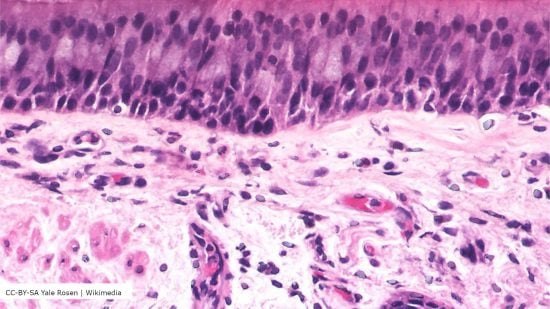
Phase 9 – Multi-lung
| Location | Chest cavity |
| Function | Gives the ability to breathe in low-oxygen and toxic conditions |
| Medical judgment | Self-contradictory |
The magical multi-function multi-lung supposedly allows Marines to breathe in low oxygen environments, toxic gases or even underwater. The problem is, the physiology that would would make it good at some of those things would make it terrible at others.
For lungs to cope in low oxygen environments, they must maximise the movement of oxygen across membranes – this requires specialised lung structure and also specialised blood systems. But hyper-efficient oxygen transfer across the lung membrane and absorption to the blood is a really bad adaptation for operating in highly toxic environments, because it just moves the toxins across quicker.
What about breathing underwater? You cannot achieve a functional level of oxygen transfer from the lung into the blood with mammalian lung structure – that’s why everything that gets oxygen out of water has gills. The things that make gills good at getting air out of water, such as a very high surface area and a neat gas-transfer enhancing feature called countercurrent flow, are exactly what you wouldn’t want in a toxin filtering organ, as we’ve said above.
Even then, the volume of gas exchange possible with gills is not enough for the metabolic demands of mammals, let alone a metabolic powerhouse like a Space Marine?
A highly toxin resistant organ would be like a gas mask or air filter – while these don’t restrict oxygen transfer, they certainly don’t enhance it. Keeping out the nasty stuff that can’t be filtered requires some kind of active transport system on the cell membrane that prevented passive transport or membrane diffusion, and that would definitely impair oxygen transfer. And corrosive gases that simply destroy lung tissue don’t really care how special your lungs are.
Finally, as we’ve said above – the chest cavity is prime real estate. Forget the extra organs – just make the heart and lungs bigger.
Phase 10 – Occulobe
| Location | Occular nerve |
| Function | Improves eye functionality |
| Medical judgment | Adjusting eye functionality seems possible, but improvement is questionable |
The occulobe allows chemotherapy administered by Space Marine apothecaries to alter the cellular makeup of retinal cells. Genetically modifying the makeup of retinal cells feels feasible with the 40k tech levels, and we can look at the variety in the animal kingdom for examples of different things that an eye can do. So an organ that changes how eyes function seems plausible.
But all eyes are a compromise between different features. There is a finite space in your eye, and it’s already packed with light sensing cells. There’s a balance between motion detection, light detection, color detail – with finite space you can’t have the maximal amount of everything.
Perhaps the human genetic heritage that lets us know the difference between Wild Rider Red and Evil Sunz Scarlet paints for miniatures would be less useful for a Marine than superior low-light vision, so some Marine Chapters would make the trade-off. Then again, maybe the aesthetically minded Blood Angels would trade in some of their night vision for better skill creating their frescoes and portraits…
Phase 11 – Lyman’s ear
| Location | Replaces one original ear |
| Function | Improves hearing, balance, allows conscious noise filtering |
| Medical judgment | Plausible, but some of its functions aren’t really ear related |
The Lyman’s ear enhances hearing and allows for sound filtering. This one’s a maybe. Being able to change the tension of your eardrum could be useful, and would help cope with sudden pressure changes, or vary which frequencies of noise are audible. Direct control of the Eustachian tube between your middle ear and your throat would also enable you to cope with pressure extremes.
Filtering sounds is a cognitive skill, though, not an ear-related issue. Selective attention sits firmly in the brain, and not in your ear bones (ossicles).
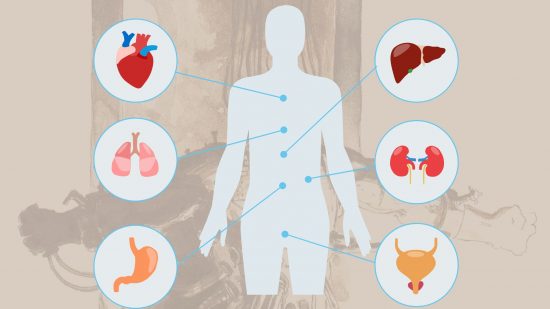
Phase 12 – Sus-an Membrane
| Location | Implanted into the brain |
| Function | Allows a Marine to enter suspended animation |
| Medical judgment | Just impossible |
Once implanted in the brain, the Sus-an membrane allows suspended animation. The longest known period of deanimation followed by successful reanimation is 567 years in the case of brother Silas Err of the Dark Angels (d.321 M.37).
Without significant external factors, this just isn’t possible. Any metabolic activity needs energy, and for energy you need to consume mass. Degradation occurs without it. This degradation comes in the form of cells dying, symbiotic bacteria in and on you expiring, and general structural decay. Life can only be sustained by constant repair and replenishment oof components.
Unless you totally freeze or dehydrate organic material, life also has to combat dehydration, fluids getting into the wrong places, organelle functionailty going whacky – it’s just not going to happen.
You are also not the only metabolically active organism in your body – symbiotic bacteria will happily turn you into lunch if your body stops policing their actions.
Phase 13 – Melanochrome
| Location | Attached to lymphatic system |
| Function | Allows the skin to darken rapidly in response to radiation |
| Medical judgment | Completely believable, but might not need a separate organ |
The melanochrome organ monitors radiation levels and can darken the skin to protect it from ultraviolet exposure and other radiation. We already understand this process pretty well, and humans do it already. Ultraviolet light causes cells called melanocytes to release pro-opiomelanocortin – and after many more long named intermediary steps, melanin is released into the skin, protecting your DNA from UV damage.
This process is already happening in your standard Mk I human. Given that we’re granting the Warhammer 40k universe the ability to alter human gene lines, this seems perfectly possible.
Phase 14 – Oolitic Kidney
| Location | Abdominal cavity |
| Function | Super-powered detoxifier – can even run a full dialysis, at the expense of shutting down most other functions |
| Medical judgment | Possible, but extra |
The oolitic kidney is a super-efficient kidney, which can also (in coordination with the secondary heart) turn on a turbo-filter mode. This routes the entire circulation through the oolitic kidney to filter out critical toxins but shutting down most of the rest of the Marine’s system.
“This organ does what the current organ does but better” will always be technically feasible, because you already have proof of concept. Not all toxins are excreted renally (via the kidneys), some go through hepatic (liver) metabolism instead, so you’d need a combination of liver and kidney action to really deal with all poisons, but why not, this can be a cut-and-shut of two types of cells.
Emergency detox sounds fun, but shutting down blood supply to just about every other organ while doing it is a massive risk which doesn’t seem necessary. It only takes around four to five minutes for all your circulating blood to pass through your kidneys. At an average Glomerular Filtration Rate (urine production rate) of 120ml/min a set of normal human kidneys can do treat all the blood (to the extent of their powers) in 40 minutes.
Phase 15 – Neuroglottis
| Location | Upper nasal passage |
| Function | Improved taste with better poison detection |
| Medical judgment | Possible |
The neuroglottis enables super-sensitive taste, providing more information and better poison detection – it’s the Bloodhound organ. Set aside that most of what we interpret as ‘taste’ is actually smell (there are only five actual tastes your tongue can detect), and this one seems quite reasonable. Sense organs already detect harmful compounds – it’s why you sniff milk before pouring. We hope.
Phase 16 – Mucranoid
| Location | Central nervous system |
| Function | When activated by chemical stimuli, allows the secretion of waxy, protective mucus |
| Medical judgment | This one hurts my brain – no |
The mucranoid modifies the sweat glands to enable production of an oily layer, providing protection against extremes of temperature and even vacuum. It’s not an automatic process, and requires chemotherapy to activate.
If it requires external activation, why not just leave the coating as an external application? Something stored on a ship that could be sprayed on, instead of an implanted organ? But let’s press on and assume that we’re fully committed to using biological solutions to already solved problems.
Sweat glands are like little factories, not storage pods – but if you want an instant secretion, you’d need to find storage capacity. A normal human male has just over two square metres of surface area, so to cover that with a 7mm layer of insulating material (as thick as a cold water wetsuit) you would need to store 14 liters of fluid in the sweat cells. For a considerably larger Space Marine, we’re looking at 28 to 40 liters of subdermal fluid.
But there’s a problem with coating your skin in a magical, perfect insulator – temperature regulation. If you completely seal in the body so that it’s immune to any temperature loss in vacuum, what do you get? Heat stroke. 85% of heat loss is through the skin, about 22% from sweating, and assuming this new sweat is a perfect insulator, that heat is going to be trapped in the body, gradually cooking the internal organs.
Phase 17 – Betcher’s Gland
| Location | Inside the mouth |
| Function | Allows Marines to spit acid |
| Medical judgment | Silly, but plausible |
The Betchers’ gland is an organ in the mouth that can create venoms or corrosive substances. Venomous glands exist in nature – in a lot of nature. We already make very nasty acid in our stomachs – there’s reason we couldn’t make nasty stuff elsewhere! It’s still very silly.
Phase 18 – Progenoids
| Location | Neck and chest |
| Function | Contain germinal versions of all Space Marine organs which can be harvested, grown in vitro, and implanted into future space marines |
| Medical judgment | Total mystery |
The progenoid glands are the mysterious ‘gene-seed’, the source of future Space Marines and a convenient plot explanation for why there aren’t millions of them wandering about.
As for their feasibility… well, maybe. If we look at existing genetic modification (CRISPR Gene editing for one) you don’t need an implanted, self-reproducing organ to create genetically altered organisms. We can already edit genes directly and pretty efficiently. Maybe in the grim darkness of the we-can’t-remember-how-toasters-work far future, having the genetic material reproduce itself might be convenient.
It should be said, if you want self-reproducing genetically distinct people, there is a traditional method which is a very popular pastime amongst humans… If the Emperor had embedded the modifications in the gene-sequence, then all he’d have to do next would be to make Space Marines fertile. Though the Horus Heresy books give some hints that he may have explicitly not wanted that.
Phase 19 – Black Carapace
| Location | Inserted in large plates under the skin |
| Function | Allows nerve bonding with interface ports, and through them direct interface with power armor |
| Judgment | Not obviously impossible, but seems inefficient given other made-up technology in the 40k universe. |
The black carapace is a layer of material implanted under the skin that interfaces the Marine’s nervous system with the mechanics of Space Marine armor, making power armor as reactive as a second skin.
This feels reasonable in-universe – direct control of prosthetics is a growing field, and while this level of control isn’t possible yet, there’s no reason to think it never could be. If we assume the carapace is flexible, then maybe the best way of interfacing with huge nerve webs is through subdermal sheeting?
That said, Warhammer 40k already contains mind-impulse links (as found in 40k dreadnoughts, Imperial Knights, and Warhammer Titans) and it’s hard to see why that wouldn’t be more efficient – nerves are just the outer wiring, while the brain is the source of the signal.
Another gnarly feature of Black Carapace, revealed in a flashback conversation with one of the Emperor’s scientists in the novel The Great Work, is that it’s technically a form of cancer. I’m not going to delve into that any further.
Phase 20 – Sinew Coils
| Location | Metal fibre bonded to muscle sinews |
| Function | Increases muscle strength |
| Medical judgment | Feasible |
The sinew coils are the first of the three implants added to the Space Marine design by Belisarius Cawl, and they’re not really an organ – they’re a bionic implant, a series of extremely strong metal fibre bundles that enhance muscle strength.
While we don’t have a mechanism for how they work, the principle of sticking bits of metal is already proven in our world – hip transplants have been around for years.
Phase 21 – Magnificat
| Location | Brain cortex |
| Function | Turbo-charges other organs |
| Medical judgment | A copycat of other, already dubious organs |
The magnificat further enhances Space Marine growth, and turbo-charges the functionality of the other implants, particularly the hormonal or metabolic ones like the Biscopea and Ossmodula. Since those are pointless and nonsensical, respectively, we’re calling this one another impossibility – Belisarius was just copying the Emperor’s most dubious homework.
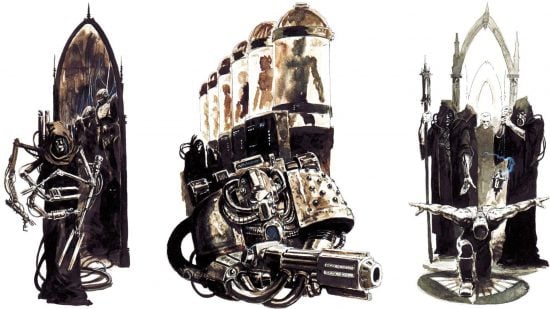
Phase 22 – Belisarian Furnace
| Location | Abdominal cavity, attached to both hearts |
| Function | Floods the body with biological combat stimms and healing compounds |
| Medical judgment | Very vaguely defined, but as it’s basically a turbo-charged adrenal gland, this is a maybe |
The Belisarian furnace was named after the egotistical mechanicus genius that invented it, and acts as a reservoir of biological stimulants and healing compounds that is released directly into both hearts during times of extreme trauma. This is the lore reason that Primaris Space Marines had two wounds and normal marines didn’t when they were first released in Warhammer 40k eighth edition.
The body already has a source of emergency stimulants, the adrenal gland, so the Belisarian furnace could be feasible as another organ that does the same thing as a real biological function only better. But the magical rapid healing factor sounds a lot like the Larraman’s Organ which, we’ve noted above, has some major drawbacks. Call this one a maybe.
Does any of this matter?
That was… Long. My blood pressure is high. Warhammer 40k is fictional, and it’s not ‘hard’ sci-fi, so its technology doesn’t have to make sense. If you can accept the Warp, the Warhammer 40k Chaos Gods and Chaos Daemons, why not a funky little kidney? That’s an entirely reasonable approach to have, and it’ll leave you calmer than me!
Just remember that while Warhammer 40k uses scientific language, it’s not presenting real science. Everything that we know about it was the creation of an author or artist putting their coolest ideas out into the world, not something that was uncovered from a real and internally consistent universe.
And hopefully, this campaign to expose where Warhammer 40k is and isn’t consistent with real human biology has taught you something new about the incredible features of our bodies.
Let us know what you thought, or if I got anything wrong, and I’ll go back to my next Great Work – how would I design Space Marine biology in a way that makes sense…
While you’re waiting for that, why not check out some of my articles about the psychology of wargaming – how to get over hobby burnout, why wargamers hate when things change and when things don’t, and how to feel better about losing at wargames.
